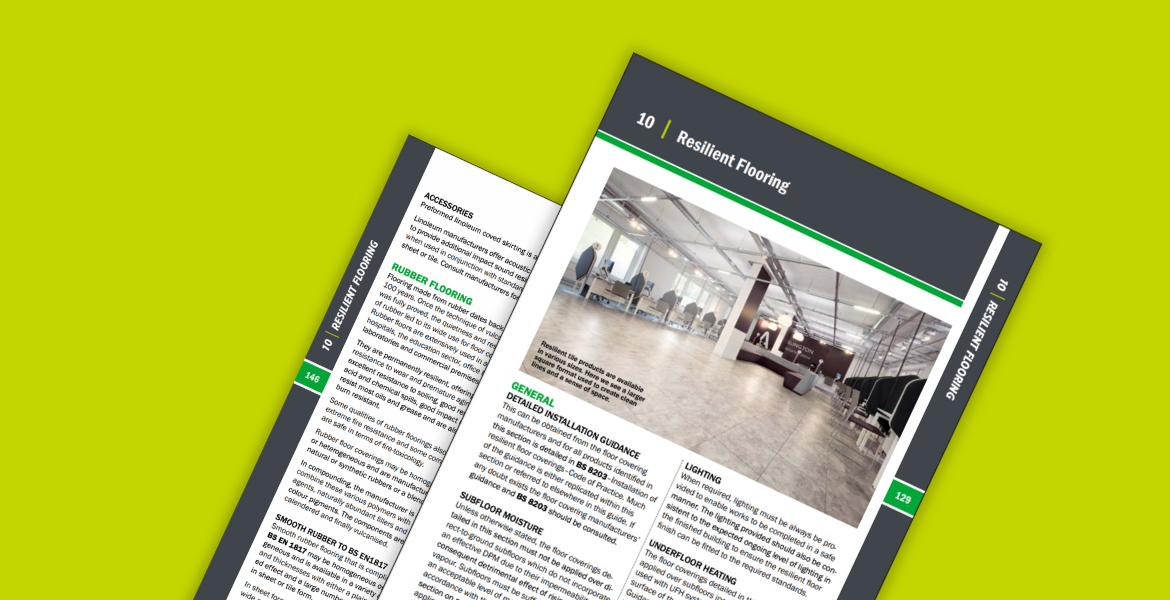
Flooring made from rubber dates back more than 100 years. Once the technique of vulcanisation was fully proved, the quietness and resilience of rubber led to its wide use for floor coverings. Rubber floors are extensively used in airports, hospitals, the education sector, office buildings, laboratories and commercial premises.
They are permanently resilient, offering excellent resistance to wear and premature aging and offer excellent resistance to soiling, good resistance to acid and chemical spills, good impact resistance, resist most oils and grease and are also cigarette burn resistant.
Some qualities of rubber floorings also possess extreme fire resistance and some compounds are safe in terms of fire-toxicology.
Rubber floor coverings may be homogeneous or heterogeneous and are manufactured from natural or synthetic rubbers or a blend of these.
In compounding, the manufacturer is able to combine these various polymers with curing agents, naturally abundant fillers and natural colour pigments. The components are mixed, calendered and finally vulcanised.
Smooth rubber flooring that is compliant with BS EN 1817 may be homogeneous or heterogeneous and is available in a variety of colours and thicknesses with either a plain or granulated effect and a large number of modern designs in sheet or tile form.
In sheet form, rolls vary between 122–200cm wide and varying lengths, normally 15lin/m and above, depending on the manufacturer, and at gauges 2–6mm. Tiles between 2–3mm thickness are usually cut from sheet, and tile sizes vary between 30cm–1sqm and 61×61cm for raised access floors.
In addition to the smooth surfaced rubber flooring, other types of rubber and/or synthetic rubber flooring are available with raised surfaces mainly in the form of ribs, studs or hammer blow surfaces, which are normally pressed out to profile in special moulds, available in a wide range of colours. This rubber flooring is usually in tile form, and apart from having a decorative value, can be used where a surface is required which offers a good degree of slip-resistance. For external use, some manufacturers offer a special quality.
Tile sizes are normally 50×50cm, 100×100cm and 61×61cm for raised access floors. Gauges vary according to the type of traffic conditions and are available from 2.5mm to 10mm.
Some manufacturers offer slip-resistant (safety) finishes and these should be selected with the level and type of contamination considered. The correct maintenance schedule should always be followed to ensure slip-resistant flooring maintains its slip-resistant properties for the life of the product. For further information on performance standards, selection and application of slip-resistant floor coverings, see section 16 of the CFA Guide to Contract Flooring.
Dissipative and conductive types of rubber floor coverings are available from some manufacturers. They are used to control static discharges to ultimately protect sensitive machinery and operatives. These types of flooring should not be confused with anti-static flooring, of which most rubber floor coverings possess inherent properties (body voltage generation). See section 18 of the CFA Guide to Contract Flooring. It is important that dissipative and conductive floorings are installed using conductive adhesives and copper strips that are connected to suitable earthing points. Always consult the manufacturer for the correct specification of these flooring types.
Rubber is available in sheet form with foam/cork backing offering higher levels of impact sound absorption, greater walking comfort and increased resilience.
The higher thermal resistance of acoustic products may reduce the efficiency of this form of heating.
In recent years, increasing use has been made of the properties of rubber to provide resilient floors suitable for a wide range of sporting activities.
Some manufacturers of rubber flooring state that seam welding is not required due to their inherent dimensionally stable properties. A correctly cut and installed seam in sheet material will not shrink or open up. Tiles are usually die-cut and do not need cutting or trimming. If seam-welding is required or requested, they can be heat sealed using colour matched hot-welding rod using standard welding equipment. It is also possible to weld vertical joins/mitres using one component sealing compound.
Rubber accessories are available in the form of sit on and set in coved skirtings. Stair accessories are also available in the form of stair stringers, all in one nosing, tread and riser “stairtreads” and separate nosings. Inserts are also available for the visually impaired to highlight step edges, consult the manufacturer for guidance.
Some manufacturers offer removable tiles, which are normally 100×100cm and are fixed with low-tack adhesives or double-sided quick fix stickers. They are designed for raised access panels where access is required, and in areas where permanent bonding is not an option.
Timber subfloors: Rubber floors have a good degree of flexibility and can be laid over suspended timber subfloors, providing the timber surface has been suitably prepared, otherwise, damage can occur on board joins.
Rubber floorings normally posses a smooth sanded backing, both in sheet and tile form. In the majority of applications, they can be adhered using modern water-based acrylic type of adhesives which must be recommended by the manufacturers of the flooring and adhesive. In certain instances, specialised fixing may be required using two-component chemical adhesives such as polyurethane and epoxy; these are normally high intensity, and industrial areas. Accessories are normally installed using contact adhesive. Although high-performance double-sided tapes are commonly specified by some manufacturers. Further guidance can be found in BS 8203 and by consultation with the flooring manufacturer.
For more information about different types of resilient flooring, consult the CFA Guide to Contract Flooring.